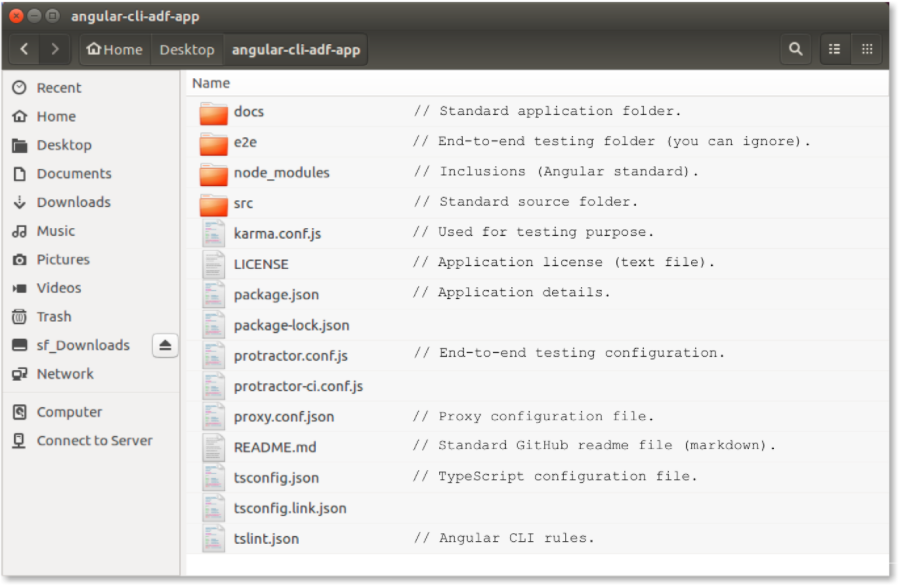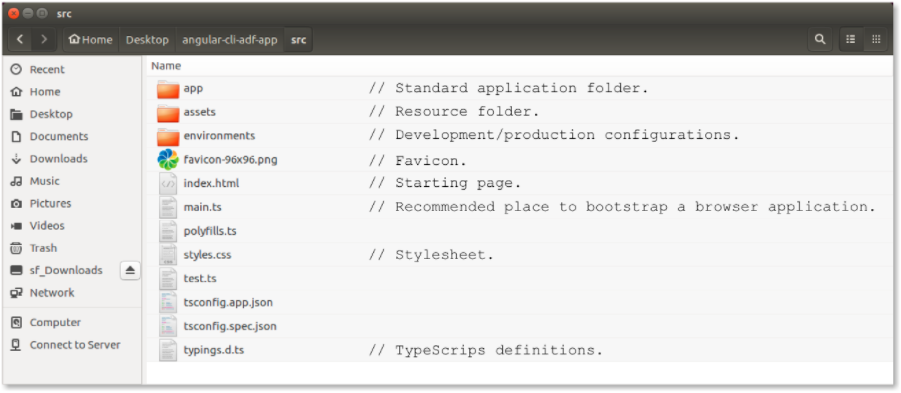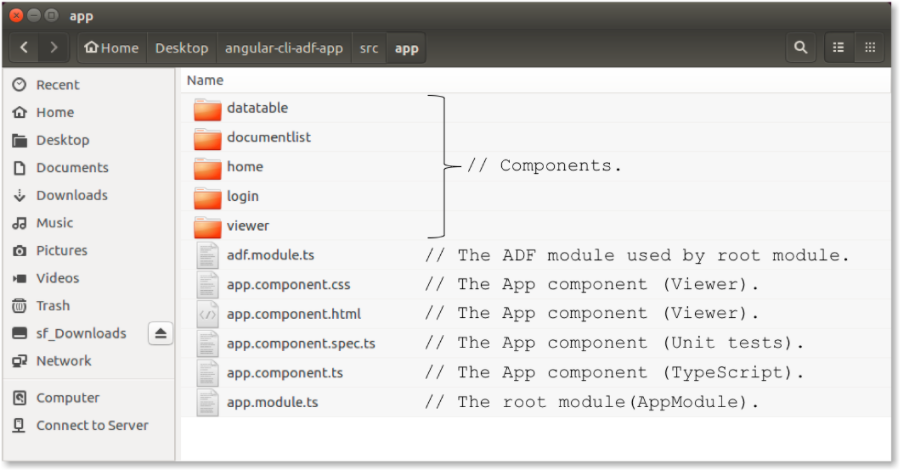Anatomy of an ADF 1.9 application
- Alfresco Hub
- :
- ADF - Forum
- :
- Anatomy of an ADF 1.9 application
Anatomy of an ADF 1.9 application
- Subscribe to RSS Feed
- Mark as New
- Mark as Read
- Bookmark
- Subscribe
- Printer Friendly Page
- Report Inappropriate Content
This content is part of the Alfresco ADF getting started tutorial and describes how to understand your Angular application built using Alfresco ADF from the angular-cli-adf-app project. In the following sections we are going to discover the anatomy of the web application to understand the basis on the definition of an Angular application.
The Alfresco ADF application as a standard Angular application
As clearly described since the very beginning, an Alfresco ADF application is a standard Angular application. If you are not familiar with the Angular development, we suggest to go through the Tour of Heroes tutorial and the Architecture Overview. It is not an easy read the very first time, but as every new technology, it will appear understandable after some training.
As a standard Angular application, an Alfresco ADF application can be described as following.
An Alfresco ADF application has a root module named AppModule. The root module is the only Angular module (or NgModule) of the whole application, even if a service module named ADFModule is provided, containing all the ADF specific modules in one place.
An Alfresco ADF application is composed by Angular Components, some of them provided by Alfresco in its Alfresco Angular Components project. The Alfresco Angular Components are released as Open Source under the Apache 2.0 license.
An Alfresco ADF application uses Angular CLI as module bundler to incorporate assets that belong together and should be served to the client in a response to a single file request.
The structure of an ADF application
Now that we know how an Alfresco ADF application is related to a standard Angular application, let’s share more details about the application’s structure. Looking at the Alfresco ADF application into the file system, we can recognise all the modules and components introduced above. In the following picture is showed an example of Alfresco ADF application, built starting from the angular-cli-adf-app project.

The structure of the application is quite straightforward, if you know how an Angular application works. All the source code is defined into the src folder, detailed in its structure, into the following picture.

Below some highlights on the most important files and folders, for the correct execution of the angular-cli-adf-app application.
index.htmlThis is the starting point for each session. The file is a regular HTML file, except for the <app-root> tag that links the root module, where all the magic happens. This file contains the<html>,<head>and<body>content, common to all the pages of our application.
main.tsThis is the TypeScript file used for bootstrapping. This file indicates where to start bootstrapping, using the AppModule class (the Angular root module) declared into theapp/app.module.tsfile.
- app folder. This folder contains the core content of the Angular application, defined by the root module and the components. In the following picture is showed the corresponding app folder of our
angular-cli-adf-appapplication.

Below some highlights on the most important content in the app folder.
- app.module.ts This is the TypeScript file containing the AppModule class (the Angular root module). This class defines:
- The list of Angular components, used in the application. In this specific application they are hosted into the components folder.
- The Angular routing to enable the navigation from one view to the next.
- The bootstrapping component, in our case named AppComponent, stored into the app.component.* files.
app.component.css,html,spec.tsandtsThose files define a standard Angular component, controlling a patch of screen called a view. In particular:app.component.cssdefines the specific stylesheet of the component.app.component.htmldefines the HTML generated by the component (in this case, exactly where the tag<app-root>appears into theindex.htmlfile).app.component.spec.tsis the Unit Tests in TypeScript for the component.app.component.tsis the TypeScript file declaring theAppComponentclass implementing the real business logic (and behavior) of the component.
- The component folders. The folders contain all the Angular components used in the application. In the picture: DataTable, DocumentList, Home, Login and Viewer. The implementation of each Angular component, really depends on the component’s role and goal in each specific application. We won’t detail here the listed components, because some of them are extremely specific for this sample application.
Material 2 in ADF applications
Before moving a step further, there is another topic to discuss about the ADF applications: the stylesheet. ADF applications are designed and developed to work with the Material 2, the Google's Material Design components for Angular. We won’t discuss here the basis of that design language. If you want to learn more about it, you can start from the Official Documentation for a better understanding.
From a technical point of view, the relevant thing we are interested to share, is that every ADF application is designed according to Material 2. And this means:
- In the
style.cssfile you can find the inclusions for Material 2 in terms of Cascading Style Sheets.
- Each ADF component generates the HTML portion, according to the Material 2. You can find the HTML template in the *.component.html file of each folder containing an ADF component.
- Each ADF component can have a custom stylesheet declared into the
*.component.cssfile. If you check into theangular-cli-adf-appapplication, in particular into each folder containing an ADF component, you can find a*.component.cssfile, or you cannot find it if the default Material 2 is enough. Those*.component.cssfiles are exactly the place where we are going to act to customise the colours and stylesheet in general.
These are all the main basis to understand the anatomy of a standard Angular application built using Alfresco ADF, from the angular-cli-adf-app project.
Blog posts and updates about Application Development Framework (ADF).
- Extending the Alfresco Digital Workspace (ADW)
- Developing Take Ownership Extension for ACA 2.8.0
- Creating your first extension for Alfresco Content...
- ADF 4.0.0 is out!
- Hey Front-End Developer, what are your preferred o...
- We want to (thank and) reward our ADF contributors...
- How to update ADF from version 2.5.0 to 2.6.1
- Application Development Framework (ADF) 2.6.1 Rele...
- ADF 2.6.0 Release Note
- How to update ADF from version 2.4.0 to 2.5.0
- ADF 2.5.0 Release Note
- ADF 2.4.0 Release Note
- How to deploy an ADF APP
- How To Add The New Sidenav Layout Component In You...
- How to integrate ADF log service with Mixpanel an...
We use cookies on this site to enhance your user experience
By using this site, you are agreeing to allow us to collect and use cookies as outlined in Alfresco’s Cookie Statement and Terms of Use (and you have a legitimate interest in Alfresco and our products, authorizing us to contact you in such methods). If you are not ok with these terms, please do not use this website.
